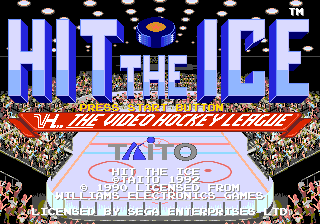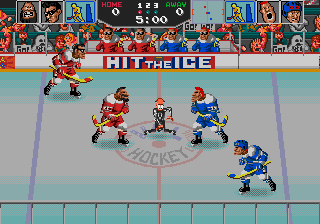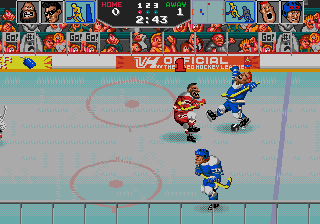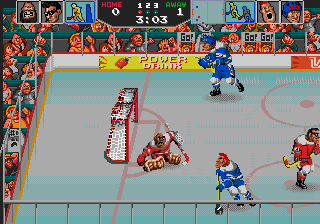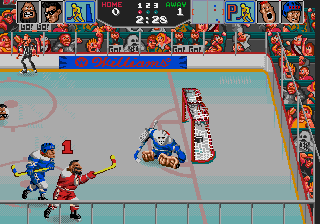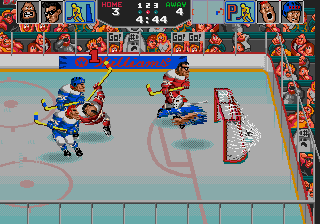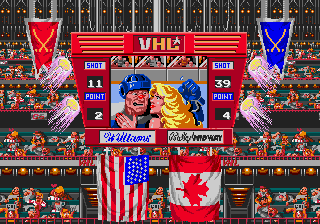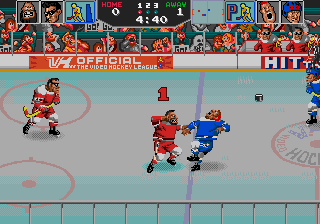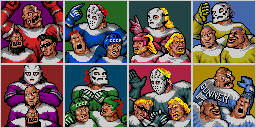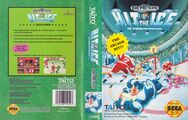Hit the Ice
From Sega Retro
| Hit the Ice | ||||||||||
|---|---|---|---|---|---|---|---|---|---|---|
| System(s): Sega Mega Drive | ||||||||||
| Publisher: Taito America | ||||||||||
| Developer: Aisystem Tokyo | ||||||||||
| Original system(s): Taito System B | ||||||||||
| Developer(s) of original games: Williams Electronics Games, Taito | ||||||||||
| Genre: Sports (ice hockey) | ||||||||||
| Number of players: 1-2 | ||||||||||
| ||||||||||
|
Hit the Ice is a 1990 arcade ice hockey game for Taito's B System arcade hardware by Williams Electronics Games. Aisystem Tokyo ported the game to the Sega Mega Drive in 1993, releasing it exclusively in the US.
Contents
Gameplay
Hit the Ice is an arcade-style hockey game in which two teams of three players (one forward, one defense, and one goalie) compete against each other. Most of the rules of the original sport are dropped, so there are no fouls, and the aim of the game is simply to hit the hockey puck into the opposition's net by any means necessary (including hitting opposing players). Arcade sports games of this nature (where rules are sacrificed for quicker and more aggressive gameplay) were popular in the late 1980s and early 1990s, so the game can be considered an ice hockey equivalent to Arch Rivals or the later NBA Jam.
Games consist of three periods that are 5 minutes long (though the period length can be changed in the options). The game can be played by one player against the computer or by two players cooperatively (against the computer) or competitively (against each other). Goals are always worth one point each. If the game is tied at the end of the third period, it goes into a sudden death period where the first team to score wins.
Modes
The game has the following modes:
- Com vs. Play 1: Plays a one-player game against the computer.
- League Play: Plays a series of games against every other team in the game (for a total of seven games). This mode is a single player against the computer. There is a password system for continuing.
- Play 1 vs. Play 2: Plays a two-player game against each other (with each player on separate teams).
- Com vs. 2 Plays: Plays a two-player game against the computer (with both players on the same team).
- League 2 Plays: Plays a series of games against every other team in the game (for a total of seven games). This mode is for two players against the computer (with both players on the same team). There is a password system for continuing.
In the options, players can set the difficulty level of computer opponents (Easy or Normal), the game speed (between 1 and 5), the length of each period (2, 5, 10, or 20 minutes), and whether obstacles are enabled.
Obstacles
Fans occasionally throw these objects onto the ice.
| Bottle | |
|---|---|
| Causes a skater to slip. | |
| Octopus | |
| Causes a skater to fall. Likely a reference to the Legend of the Octopus. |
Teams
There are no real teams but a selection of fake teams that are part of the fictional Video Hockey League (VHL). Like the NHL, VHL teams hail from Canada or the United States. The original arcade game only had two teams (the Reds and the Blues), which was expanded to eight teams for the Mega Drive port.
When selecting a team, pressing ![]() shows the statistics for each team member (in five categories: Speed, Shot, Pass, Defense, and Stamina) and pressing
shows the statistics for each team member (in five categories: Speed, Shot, Pass, Defense, and Stamina) and pressing ![]() chooses the team. Players can choose the same team.
chooses the team. Players can choose the same team.
| Reds | |
|---|---|
| Blues | |
| Pinks | |
| Yellows | |
| Purples | |
| Greens | |
| Grays | |
| Skyblues | |
Magazine articles
- Main article: Hit the Ice/Magazine articles.
Promotional material
also published in:
- Electronic Gaming Monthly (US) #44: "March 1993" (1993-xx-xx)[2]
- Electronic Gaming Monthly (US) #45: "April 1993" (1993-xx-xx)[3]
Physical scans
| Sega Retro Average | |||||||||||||||||||||||||||||||||||||||||||||||||||||||||||
|---|---|---|---|---|---|---|---|---|---|---|---|---|---|---|---|---|---|---|---|---|---|---|---|---|---|---|---|---|---|---|---|---|---|---|---|---|---|---|---|---|---|---|---|---|---|---|---|---|---|---|---|---|---|---|---|---|---|---|---|
|
| 49 | |
|---|---|
| Based on 11 reviews | |
Technical information
- Main article: Hit the Ice/Technical information.
References
NEC Retro has more information related to Hit the Ice
|
- ↑ Sega Visions, "February/March 1993" (US; 199x-xx-xx), page 100
- ↑ Electronic Gaming Monthly, "March 1993" (US; 1993-xx-xx), page 95
- ↑ Electronic Gaming Monthly, "April 1993" (US; 1993-xx-xx), page 115
- ↑ 1700 igr dlya Sega, "" (RU; 2001-xx-xx), page 96
- ↑ Consoles +, "Mai 1993" (FR; 1993-0x-xx), page 104
- ↑ GameFan, "Volume 1, Issue 5: April 1993" (US; 1993-xx-xx), page 15
- ↑ Sega Mega Drive Advanced Gaming, "June 1993" (UK; 1993-04-29), page 40
- ↑ Mega, "May 1993" (UK; 1993-04-15), page 57
- ↑ Mega Fun, "05/93" (DE; 1993-0x-xx), page 74
- ↑ Play Time, "6/93" (DE; 1993-05-05), page 96
- ↑ Sega Power, "June 1993" (UK; 1993-05-06), page 44
- ↑ Sega Pro, "July 1993" (UK; 1993-06-10), page 67
- ↑ Sega Force Mega, "August 1993" (UK; 1993-06-24), page 56
- ↑ Tricks 16 bit, "Tricks Sega Gold 800 igr" (RU; 1998-03-20), page 86
| Hit the Ice | |
|---|---|
|
Main page | Comparisons | Magazine articles | Reception | Region coding | Technical information | Bootlegs | |
